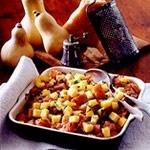I’ve often wondered how people come up with the names of some of our foods. I mean really... artichokes? Passion fruit? Squash? Squash is a game, an action verb, and a food. I’m just saying...
The English word "squash" derives from askutasquash (a green thing eaten raw), a word from the Narragansett language, which was documented by Roger Williams, the founder of Rhode Island, in his 1643 publication
A Key Into the Language of America. Similar words for squash exist in related languages of the Algonquian family such as Massachusett. (You’ve got to love Wikipedia!)
If someone were to ask you if squash were a vegetable or a fruit, what would you answer? If you said “fruit”, you’d lose the million dollars! Although squash is considered a vegetable in cooking, botanically speaking, squash is a fruit (being the receptacle for the plant's seeds). Squash can be served fresh (in salads) and cooked (squash stuffed with meat, fried squash, baked squash). Small pattypans are good for pickling. What is a pattypan?
 Pattypan:
Pattypan: pattypan comes in yellow, green, and white varieties. The squash is most tender when relatively immature; it is generally served when it is no more than two to three inches in diameter. In fine cuisine, its tender flesh is sometimes scooped out and mixed with flavorings such as garlic prior to reinsertion; the scooped-out husk of a pattypan also is sometimes used as a decorative container for other foods.
Pattypan is a good source of magnesium, niacin, and vitamins A and C. One cup contains approximately 20 to 30 calories and no fat. It is often sliced, coated and fried until golden brown. In Polish cuisine they are pickled in sweet vinegar.
Whew! Now for some recipes!
Acorn Squash with White Beans and Sage
From Good Housekeeping
Serves 4

1 tablespoon(s) olive oil
1 onion, cut into 1/4-inch dice
1 medium carrot, cut into 1/4-inch dice
2 clove(s) garlic, crushed with press
1 can(s) (15 to 19 ounce) white kidney beans, rinsed and drained
3/4 cup(s) vegetable broth
1/4 teaspoon(s) salt
1/4 teaspoon(s) Coarsely ground black pepper
3 teaspoon(s) fresh sage leaves, chopped
2 small acorn squashes
1 medium tomato, cut into 1/4-inch dice
Fresh sage sprigs for garnish
Grated Parmesan cheese (optional)
1. In nonstick 12-inch skillet, heat oil over medium-high heat until hot. Add onion, carrot, and garlic, and cook 15 minutes or until vegetables are tender and golden, stirring occasionally. Add beans, broth, salt, pepper, and 2 teaspoons chopped sage; heat to boiling. Cover skillet and keep warm.
2. Meanwhile, cut each squash lengthwise in half and remove seeds and strings. Place squash halves in 3-quart microwave-safe baking dish. Cover and cook in microwave oven on High 6 to 8 minutes or until squash is fork-tender.
3. Place squash halves, cut side up, on platter. Fill each half with one-fourth of bean mixture; sprinkle with diced tomato and remaining 1 teaspoon chopped sage. Garnish with sage sprigs. Serve with Parmesan if you like.
Tips & Techniques
Recipes calling for a microwave were tested in a 1,100-watt microwave oven. If your microwave has more or less power, it may be necessary to make adjustments in cooking times to reach desired doneness.
 Download this recipe.
Polenta Bake With Butternut Squash
Serves 4
Download this recipe.
Polenta Bake With Butternut Squash
Serves 4

1 log(s) (24 ounces) precooked polenta
1 package(s) (about 20 ounces) butternut squash chunks, cut into 3/4 inch pieces*
4 teaspoon(s) olive oil
1 (1-pound) jumbo onion, cut into 1/4-inch dice
2 clove(s) garlic, crushed with press
1 1/4 cup(s) low-fat 1 percent milk
2 teaspoon(s) cornstarch
1/2 teaspoon(s) salt
1/8 teaspoon(s) coarsely ground black pepper
6 tablespoon(s) (grated) Parmesan cheese plus additional for serving
1/2 cup(s) (chopped, loosely packed) fresh basil leaves
1. Preheat oven to 450 degrees F. Cut polenta log crosswise in half, then cut each half lengthwise into 4 slices. In 8- by 8-inch ceramic or glass baking dish, place 6 slices polenta. Cut remaining 2 slices into 1/4-inch dice; set aside.
2. In nonstick 12-inch skillet, heat oil over medium heat until hot. Add onion and garlic, and cook 5 minutes, stirring occasionally. Add squash; cover and cook 15 minutes longer or until vegetables are tender and lightly browned, stirring occasionally.
3. Meanwhile, in 2-cup liquid measuring cup, stir milk, cornstarch, salt, pepper, and 4 tablespoons Parmesan until well-combined. Add milk mixture to skillet; heat to boiling over medium-high heat. Reduce heat to low; cook 2 minutes, stirring occasionally.
4. Bake polenta slices in baking dish 10 minutes or until heated through. Spoon squash mixture over polenta slices; top with diced polenta and remaining 2 tablespoons Parmesan. Bake 5 minutes or until heated through. Sprinkle with basil before serving. Serve with additional Parmesan if you like.
Contribute to the Cook'n Club!
DVO would love to publish your article, prose, photography and art as well as your cooking, kitchen and nutrition tips, tricks and secrets. Visit the Newsletter Submission / Win Win for All section in our Forum for more information and details.



